After first hearing about the native woodland scheme at Muckrach I submitted a Freedom of Information request to Scottish Forestry (SF) for its contract with Calthorpe Estates, the family trust which owns the land, and any reports from inspection visits. Just like when the BrewDog Lost Forest disaster become apparent (see here), it turns out that Scottish Forestry sent out inspectors to check the planting on 13th June. Credit for that almost certainly lies with Calum Campbell who had pressing Scottish Forestry about the damaging impact the scheme had had on wildlife since his Facebook post in April (see here).
At the time of my information request the Inspection Report was still in draft form but the very helpful person at SF who deals with FOI requests sent me a copy once it was complete. In my view the public should not have to request such reports, Scottish Forestry should be publishing them on its online grants database as a matter of course
What the inspection report covers
The primary driver behind what Scottish Forestry does is to meet the tree planting targets set by the Scottish Government (see here) and, where grant is awarded to meet that objective, to ensure it delivers the number of trees specified in the contract with landowners. That is evident at the very start of the inspection report:
Summary findings
Excepting the issues identified below woodland creation has been undertaken in accordance with the approved plan. Plot data identified minimum stocking density has been achieved or exceeded [i.e targets have been met] across the site. Trees appear healthy, though some minor localised hare damage was encountered. Associated protection measures vole guards, fencing and gates were identified as per the approved contract, though approx. 4m of fence between NH 9923 2792 and NH 9944 2724 was found not to have been marked.
This limited focus is further confirmed by the second paragraph in the report:
Area not planted
Two discrete but considered mappable areas (>0.25ha) identified as woodland creation on the approved plan and claimed have not been planted, though naturally regenerating trees are present NH 9849 2956 and NH 988 271. An area of mappable deep peat 0.35ha was identified within the claim though this has not been planted NH 9833 2797. The over declaration will be measured by SF as soon as is practicable to determine the outcome in accordance with FGS procedure for over-declaration of expenditure in advance of progressing the capital claim.
While not wishing to excuse the apparent dishonesty, one of the few things Savill’s has got right at Muckrach was its decision not to plant two small areas covered with naturally regenerating trees and an area of deep peat. Just why Scottish Forestry ever agreed these areas should be planted in the first place is the important question that needs to be answered. Clearly the surveys used to justify the planting were not fit for purpose (just like at the Lost Forest (see here)).
From a nature and climate change perspective the important point to note about the inspection is it only covered issues relating to the impact that the Muckrach woodland creation has had on the natural environment where these are specifically covered by the contract. Within this limited scope what is documented in the report is, just like that for the Lost Forest, generally excellent and a credit to the authors.
The report confirms many of the problems I identified in my first two posts on the Muckrach native woodland scheme (see here) and (see here). It is, however, the “issues identified below” the “summary findings” which touch on what really matters. The summary itself, while no doubt music to the ears of Scottish Forestry’s senior management preoccupied with planting targets, is not justified from an environmental perspective. That is not the fault of staff undertaking the inspection but rather a consequence of the way the Scottish Forestry grants system has been designed and administered.
While the report gives grid references for all the “contractual issues” identified, nowhere does it explain the geographical scope of the inspection. It is not clear therefore whether it is comprehensive or whether there may be further instances where Savills, who managed the work on behalf of Calthorpe Estate, breached the contract with Scottish Forestry.
Planting on and destruction of deep peat
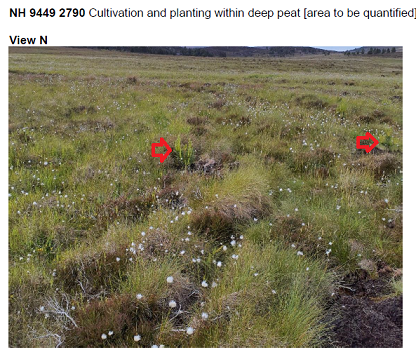
The inspection report documents two examples where trees have been planted on deep peat (over 50cms deep). This is now contrary to Scottish Government policy because of the carbon emissions it causes and the damage it does to bog habitats. Unfortunately, the inspection did not quantify the area affected so it is not possible to ascertain just how much damage has been done. That the tree planting contractors, however, were allowed anywhere near the bog in the photo is an indication of just how poorly these native woodland creation schemes are being managed.
It also provides another example of just how much public money is being wasted on large landowners in the name of addressing the climate and nature crises. While Scottish Forestry has been paying Calthorpe Estates to plant trees the Cairngorms National Park Authority (CNPA) has been paying them money to “restore” peat bog:
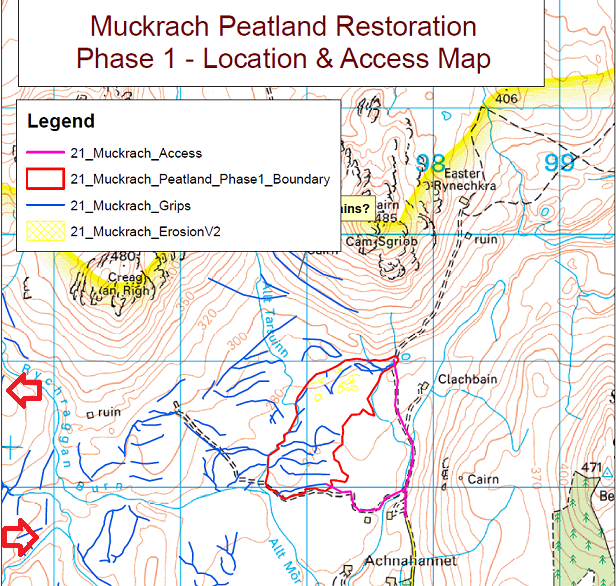
The photo above was taken just east of the area covered by this map, as indicated by the top arrow.
The photo below is of the area marked by the lower red arrow.
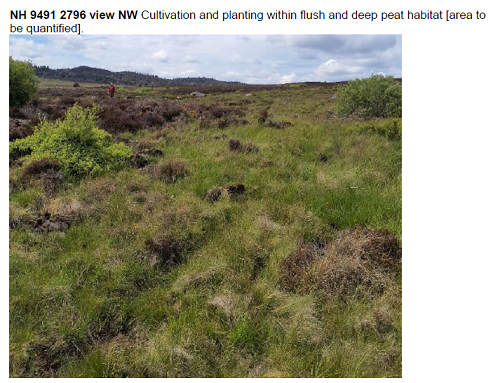
Both areas would appear to fit the criteria for peatland restoration in future having been artificially drained. Whatever plans the Peatland Action team at the CNPA might have had for this land in future, cultivating such ground to plant trees should be a criminal offence. There is no indication, however, from the Scottish Forestry report that anyone from Savills is to be held to account.
The report also shows that the Muckrach estate is still, apparently, in other places trying to drain the bog and has caused yet more damage by driving vehicles across it:
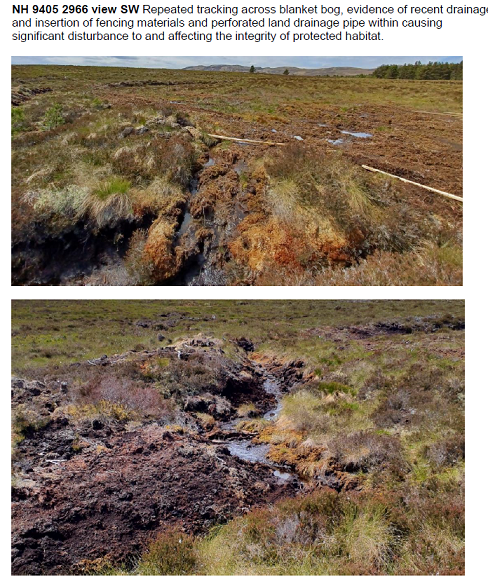
The Wildlife Management and Muirburn Act may have banned burning on deep peat but was a lost opportunity to provide comprehensive protection to bogs. Given all the holes in our regulatory frameworks, the recommendation of the inspectors in response to this destruction was positive and sensible:
“Areas of deep peat and flush should have all planted trees removed and mounds reinstated using techniques that result in no further disturbance to surrounding habitat.”
“Planting within close proximity of existing trees and regeneration”
The report helpfully explains the clauses in Scottish Forestry’s contract with Muckrach designed to protect natural regeneration:
“Page 24 of the Operational Plan and page 5 section 4.b2 of the Issues Log confirms a 10m buffer would apply to existing trees and regeneration; and that within the enrichment planting areas the focus would be on manual mounding. Evidence of encroachment within this buffer and mechanical mounding was observed during the site visit. Two locations highlighted below, though this practice was also observed around existing trees and regeneration in the western compartment to the north and east of Creag Coille na Moille.”
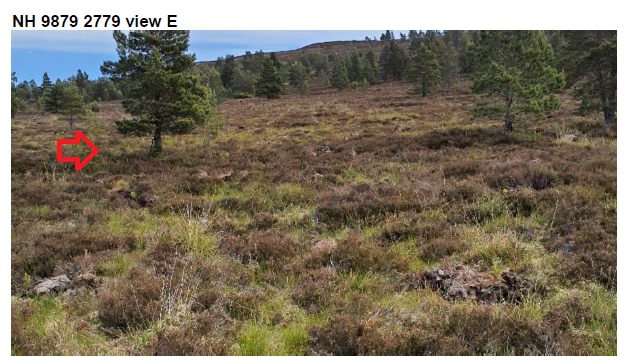
Unfortunately, once again the amount of planting over or close to natural regeneration has not been quantified.
Responsibility for this stupidity and further waste of public money lies with the forestry grants scheme. Since Scottish Forestry pays landowners and their agents according to how many trees they propose to plant, there is a financial incentive for all those involved in woodland creation to underestimate the amount of natural regeneration in order to plant more trees and maximise the amount of grant they can claim. Until now they have got away with it.
The photo, taken near Achnahannet, further demonstrates the stupidity of the 10m “buffer zones” around existing trees. Given the number of trees and the power of natural regeneration, there was absolutely no ecological justification for paying Calthorpe Estates to plant any of this area. It should have just been left to evolve naturally. That, however, would have undermined Scottish Forestry’s planting targets and the recommendation of the inspectors reflects that:
“Where mounding and planting has occurred within the 10m buffer of existing trees and extensive regeneration identified in the approved plan, trees should be removed and mounds reinstated using techniques that result in no further disturbance to existing trees”.
All the other unnecessary mounds can remain, leaching carbon into the atmosphere.
.
Impact of the planting on black grouse
Native woodland creation is supposed to help bird species like Black grouse and we owe it to Calum Campbell for demonstrating that the opposite has happened at Muckrach. Unfortunately, the narrow contractual focus of the Inspection Report, which found that the lekking areas identified in original surveys were not planted, misses the point:

While there are traditional lekking areas, leks change and evolve over time. Removing the planted trees from one newly identified lekking area won’t solve the real problem which is that plantations, whether of native or non-native trees leave very little space for black grouse and other species which depend on open ground to go (wildlife ranging from hen harriers to butterflies). Leaving woodland development to natural regeneration would avoid these problems because it tends to result in a patchwork of trees and more open areas which means that species like black grouse can move and adapt their habits over time.
As for the deer fencing, which kills birds whether marked or not, the operational plan approved by Scottish Forestry contained three options: use of bamboo canes, plastic netting or wooden droppers. Emails I have obtained through FOI show that the CNPA advised against the use of plastic netting, on landscape grounds, and NatureScot advised against the use of bamboo canes as there is no evidence to show they prevent collisions (they are too thin, like the wire, for birds to see). Despite that advice, Scottish Forestry did not specify the type of fence marking that was to be used and Muckrack/Savills then chose the cheapest of the three options they presented. What cost wildlife?
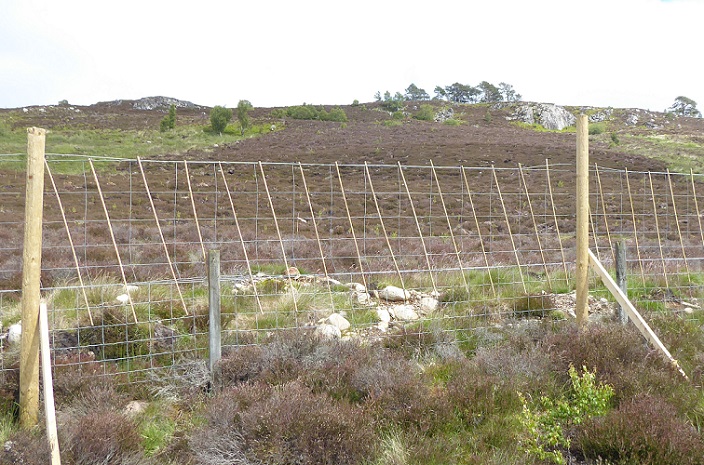
The inspectors now recommend that Muckrach should have to replace the bamboo with wooden droppers where there is a high risk of bird strike. That recommendation in my view is ridiculous and show no understanding of animal behaviour. It implies that birds are like aeroplanes and confine themselves to certain flight paths.
The recommendation also illustrates how, instead of addressing the main problem, which is that deer fencing would not be required if deer numbers were properly controlled, Scottish Forestry creates endless work for others. Thus the inspectors recommend:
“Sensitive areas to be agreed with NS [NatureScot] and RSPB in advance of marking with droppers”.
With Muckrach being within the dispersal zone of capercaillie and with fences, whether marked or not, being proven to be the single most important factor impacting on their survival rates, there is no point marking small sections of fence. The fences should never have been erected and now need to be removed completely.
Roads galore!
The Inspection Report shows that the shocking section of new road north of Achnahannet, which I covered in my first post on Muckrach, was far from the only one.

Helpfully, the Inspection Report states that:
“Issues log (June 2022) confirms that no new tracks are proposed within the approved plan. Evidence of new cuttings and upgrade to existing track observed during site visit.”
The evidence from the report also shows that Savills and their contractors completely ignored the impact on the cultural and natural heritage and just bulldozed anything that was in the way of their diggers:
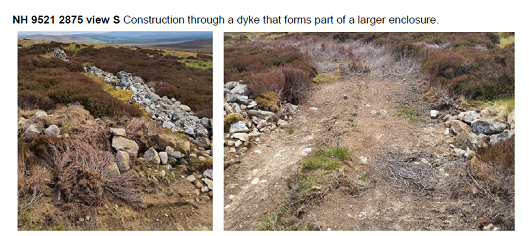
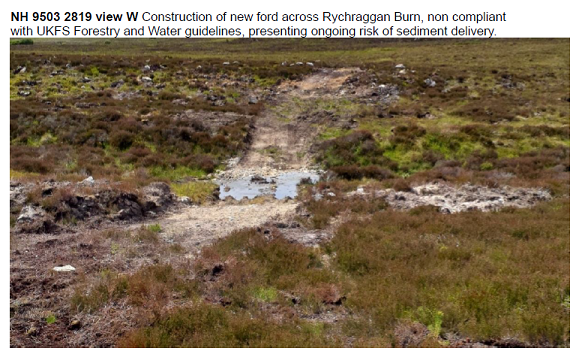
While documenting the problem professionally, the proposed solutions, which hand responsibility back to Savills and the Muckrach Estate, are not so convincing:
“Remedial Works required
Sections of newly cut track should be reprofiled to allow for rapid revegetation of native flora. Consulting archaeologist should be engaged to determine significance of damage to historic features and advise on what if any remedial action would be appropriate. The requirements of prior notification for new and existing track upgrade should be discussed with CNPA to determine what if any remedial action would be appropriate”.
It is incidentally very interesting that while Scottish Forestry ignores the power of natural regeneration when it comes to native woodland expansion, it is relying on natural regeneration of “native flora” to restore the destruction caused by this forestry grant scheme!

Where a forestry developer fails to notify the planning authority of “tracks” required for forestry purposes they cease to become “permitted developments”, dealt with under the Prior Notification system, and require full planning permission. It appears to me therefore the inspectors should have referred all these tracks to the CNPA, which has a policy presumption against new hill roads. From what I have been able to ascertain this didn’t happen and I have therefore sent a copy of the Scottish Forestry Inspection Report to the CNPA asking them to address the issues.
What needs to happen
The conclusion of the report is clearly constrained by the scope of the inspection and the UK Forestry Standard (which is not fit for purpose) but nevertheless quite helpful:
“All remedial works identified above must be planned and implemented within the scope of the UK Forestry Standard. Taking into consideration site sensitivities, such as the bird breeding season, must also be completed as soon as practicably possible, but no later than 31 October 2024 and Scottish Forestry informed”.
Unlike BrewDog, which was given five years to replace all its dead trees, Calthorpe Estates have been required to take immediate actions. The report is not clear about what monitoring arrangements, if any, are in place and more specifically whether Scottish Forestry intend to conduct another Inspection after 31st October to check on the remedial works. That is clearly needed.
Some of the remedial actions listed in the report appear to be a consequence of stricter grant conditions and greater regard for the natural environment so that Muckrach – unlike BrewDog – has been required to restore damage caused by mounding, planting and the vehicles.
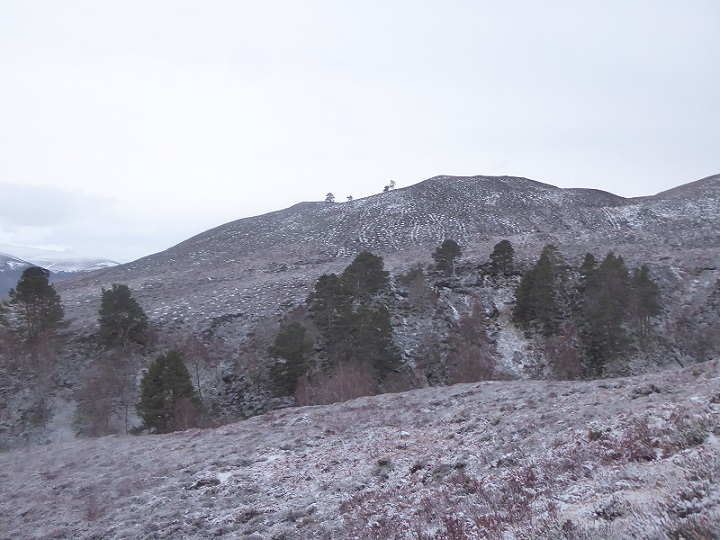
This highlights the fact that Scottish Forestry has to date failed to require BrewDog to restore similar damage it has done to the natural environment caused by the planting at Kinrara.
If senior management at Scottish Forestry are now belatedly becoming aware of all the damage that tree planting funded through their forestry grants scheme is doing to the natural environment that is welcome. The inconsistency, however, between their approach at the Lost Forest and Muckrach shows they are all over the place when it comes to protecting/restoring nature and addressing climate change and have no clear vision for the place of woodland in future. Even from their own limited perspective, however, the need to review the forestry grant scheme and how it is monitored and enforced should now be obvious.
The underlying and much more significant issue is that so long as the Scottish Government allocates money to plant trees, rather than control grazing to enable natural regeneration, and Scottish Forestry is driven by planting targets the destruction being caused by native woodland creation and commercial forestry schemes is likely to continue. There was an excellent article about this by Vicky Allan in the Sunday Herald at the weekend (see here) in which I was pleased to be quoted. Perhaps the media coverage will help force Scottish Ministers, who have the power to change our rotten forestry system, to start to listen to people other than landowners, city financiers and vested forestry interests and took a look at what is happening on the ground.

We need to be a little careful with the nature of our criticisms on this one, and give some consideration to what effect that this might have.
SF have seemingly picked up 3 X areas of non compliance, (1) Not marking 4 metres of fence, (2) Not planting an area that already has regen (3) Planting an area of deeper peat. The figures suggest that these are all VERY SMALL.
Here is what I believe to be the real problem. In the past, the Scottish Government has on occasion been fined by EU auditors for not picking up on relatively small discrepancies in grant schemes, and has been embarrassed by that. They responded by putting pressure on agencies to make sure it does not happen again. That has created a culture of fear of making mistakes, with the norm being to be very prescriptive in how things should be done, and to be 100% sure about the paper trail. This ties in with EU mind sets, where they are used to doing things on a small scale. In Scotland, I have came across 2 X cases of petty bureaucracy which to me say a lot (1) A large woodland creation scheme having grant withheld because a short section of fence was 2 cms too short. (2) Same with an agricultural fence that was 20 cms out of line for a stretch.
While some people might applaud this sort of thing, they are really just seeing small things and not seeing the bigger picture.
There needs to be a concept of tolerance built in to these schemes, as happens with forest plans. What I mean by this is that small areas either planted or not planted should be tolerated as long as they are less than, say, 10% of the size of the scheme. This is important because many potential planting sites are extremely varied in their soils and vegetation. If people have to map down to 0.25 ha or below, then development of schemes gets very expensive. This is a problem because what applies to bigger schemes will inevitably have to happen to smaller schemes too. The risk is that people with fewer resources will just say it is not worth it, and the overall level of planting/ regeneration will go down.
In practice, those small areas of blanket bog will regenerate over with trees anyway if a seed source has been planted all around them. So, there is little point in throwing the book at people if small mistakes have been made, as described.
So, the answer, I feel, is to start at the top with the culture. We are no longer in the EU, so the climate of fear should no longer exist. We mandate senior SF employees to be flexible and tolerant in their handling of problems, as long as the overall ethos of a scheme is correct. This would mean they can spend more time on the big picture, rather than very small details. We allow more native woodland schemes with < 1600 trees per ha. That would produce native woodlands, not plantations. Increase the payments for natural regeneration to make them equivalent to planting, and this would send out a very strong signal.
Be tolerant of small "mistakes", but spend more time at planning stage on overall ethos and integrity of schemes. Allow a bit of creativity.
It is interesting to see this criticism of big, high profile schemes, but it is very important not to let the pendulum go too far the other way, otherwise, SF will become too frightened to consent to anything, and everyone will be worse off. Owners will get the message that it is not worth it, and at that point, you can forget about pro- active management, full stop. We need to fix our mechanisms, not destroy them. A little bit of genuine political leadership would go a long way, but not much prospect of that happening I dont think.
Give them an inch of tolerance and they take a mile of Environmental destruction.
This destruction is down to contractors trying to reduce costs and make money above all else.
The problem is there are no boots on the ground any more ….how many days have Saville’s spent here I wonder?
These investors are mega wealthy…why not appoint local project managers who are on top of the job even if it costs a little more?
Some contractors cannot be trusted…I know this from my own experience.
I don’t think the greedy corporates and “high net worth individuals” who are extracting vast sums from the public purse will change their behaviour just because someone (Nick) is actually bothering to take a look at what’s going on. Far too much easy money is on tap for that. And as for SF, if anyone there is looking over their shoulder that can only be a good thing. Leaving them to mark their own homework isn’t exactly working well is it?
Just so.
More people keep an eye on this blog than you might think. I would not under-estimate it.
As this article and many others previously have pointed out, the easiest and most cost effective way to create woodland that protects nature, sequesters carbon and leads to tangible local economic opportunities in the future is natural regeneration. The only financial cost is culling deer and even that can be done at a profit in the hands of experienced managers. Why not simply rule out planting on all peaty hill ground….that is Land Capability for Forstry classes 6 and 7.
The merchant bankers and the landed establishment will be unhappy and there will be no Gongs available to the senior staff of Scottish Forestry on retirement but it is the obvious and best policy.
Another excellent blog and it was great to see the article in the Herald. While some of the issues might be quite small (as posted in the first comment) if this is repeated over many sites the effect is cumulatively much greater. The section on planting near peat reminds me of a situation on a hill at the other end of the country in Galloway where planting has been carried out adjacent to and I think partially on a peat bog. A small area remains but in essence its surrounded by Sitka on a hill that will barely be visited- and much less so now. All of this is done on the assumption that no one will notice. Credit to this blog for highlighting poor practice and a monumental waste of tax payers money.